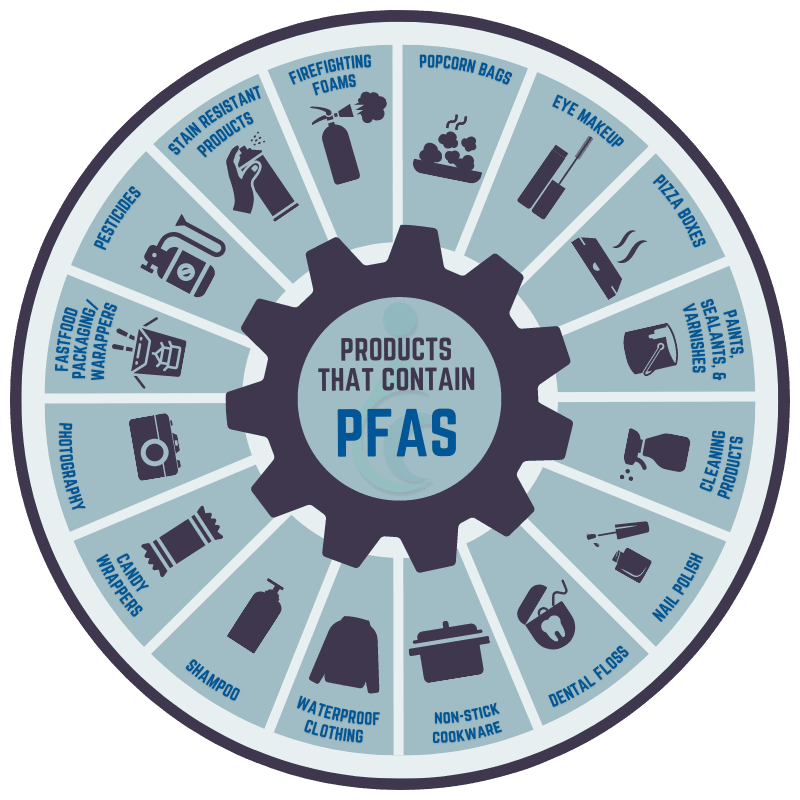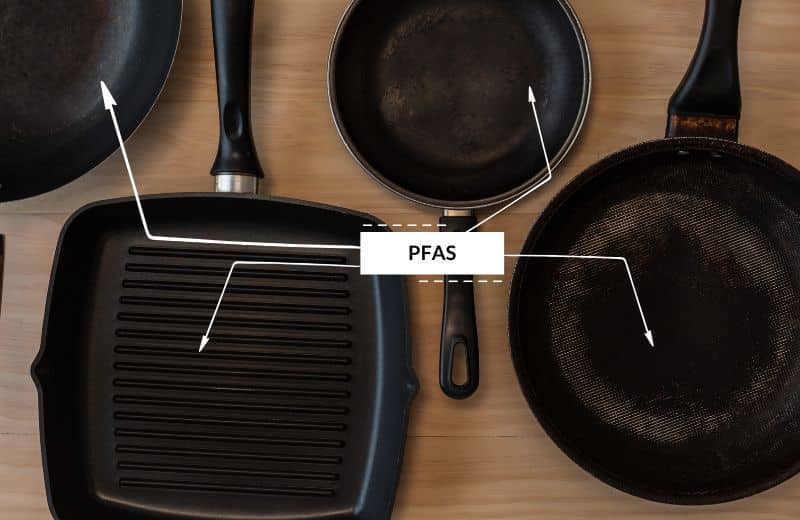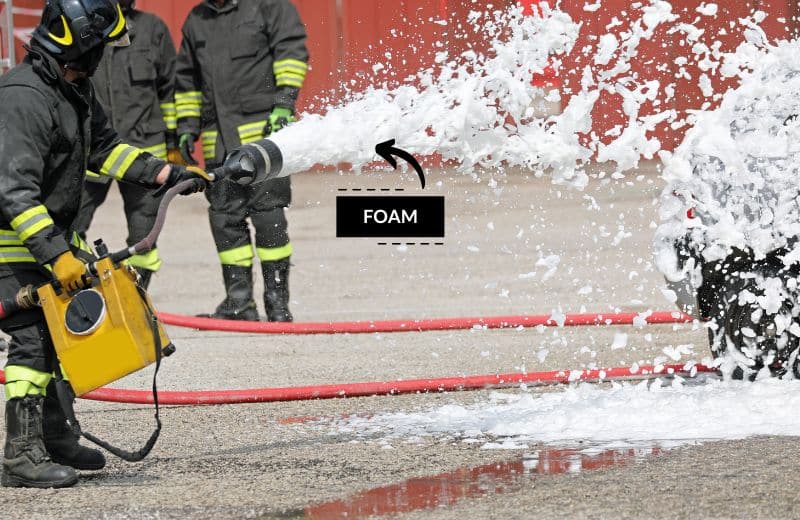Now that the dangers of PFAS chemicals are well-known, we don’t blame you if you want to do everything you can to limit your exposure to these forever chemicals.
Here, we’ve shared a list of products that are often made with PFAS, so you can choose safer, healthier alternatives whenever possible.
📌 Key Takeaways:
- PFAS, or polyfluoroalkyl substances, are a group of chemicals that have been linked to health problems including cancer, high blood pressure, high cholesterol, weight gain, immune system effects, thyroid disease, and more.
- Products that may contain PFAS include drinking water, food packaging, water-resistant textiles and outdoor gear, stain-repellent carpets and upholsteries, firefighting foam, non-stick cookware, and many more household products.
🤔 Are PFAS Still Used In The US?
You might assume that, now we’re more aware of the potential health effects of toxic PFAS chemicals, our use of these chemicals would be banned or illegal.
However, while the use of PFAS has largely been phased out in the US, manufacturers have simply replaced these chemicals with shorter-chain substitutes, which are thought to be similarly toxic to humans. Plus, you may own many products at home that were made before the PFAS phase-out and are therefore potentially unsafe.
Additionally, the problem still remains that PFAS are classed as “forever chemicals” because they linger in the environment for decades. So, we’re still being exposed to these chemicals even if they’re not commonly used today.

☢️ Products That Contain PFAS
Here is a list of some of the products that may contain PFAS:
- Non-stick cookware, such as Teflon and other PTFE-based coatings.
- Stain-resistant carpets and upholstery, including furniture and curtains.
- Water-resistant clothing and outdoor gear, such as rain jackets and tents.
- Food packaging materials, such as pizza boxes, microwave popcorn bags, and fast food wrappers.
- Firefighting foam and other firefighting equipment.
- Dental floss and stain-resistant dental coatings.
- Personal care products, such as waterproof mascara, sunscreen, and shaving cream.
- Lubricants and hydraulic fluids used in industrial equipment.
- Electrical wires and cables, especially those used in aerospace and military applications.
- Building materials, such as sealants, adhesives, and insulation.
It’s important to note that not all products containing PFAS are labeled as such, so it can be challenging to determine if a product contains these chemicals.
Now let’s explore a bit more in depth the products which are most likely to expose you to PFAs substances.
Drinking Water
Drinking water is one of the main sources of PFAS exposure in the US. PFAS chemicals enter surface water supplies through wastewater discharge, runoff from industrial sites, airfields, and fire training sites, and landfills. Leaks and spills can also cause PFAS to run into natural bodies of water.
The problem arises when these water sources are used as drinking water supplies. Most water treatment plants are ill-equipped to remove PFAS using existing treatment methods, and the EPA doesn’t currently regulate these chemicals (although it is in the process of proposing a drinking water standard), so water utilities don’t legally have to remove them.
How can you find out whether your tap water contains PFAS? We recommend checking your Water Quality Report, which lists all the contaminants detected in your public water supply. You could also test your water with a private laboratory test if you wanted the most accurate results.

Greaseproof Bags and Containers
PFAS chemicals are still authorized to be used as grease-proofing agents in grease-resistant paper and bags, microwave popcorn bags, fast-food wrappers, take-out containers, pizza boxes, any other kind of grease-resistant packaging, and bags of pet food.
The purpose of PFAS is to prevent grease and oil from leaking through the container or food packaging. You may be exposed to PFAS from products that use these chemicals as greaseproofing agents because the PFAS could contaminate the foods stored inside the packaging.
Non-Stick Cookware
Non-stick cookware is another common source of PFAS exposure today.
PFAS are used to prevent foods and ingredients from sticking to frying pans, pots, and other items of cookware.
Again, this comes with a likelihood that traces of the PFAS used to coat the cookware surfaces will leach into your food as you cook it, so you end up ingesting PFAS chemicals in your food.
If you want to avoid PFAS in your cooking equipment, look for ceramic pots and pans, which are non-stick and shouldn’t contain these dangerous chemicals. Read the manufacturer’s marketing materials to look for mentions of PFAS, PFOA, or PTFE, and contact the manufacturer if you’re unsure.

Water-Repelling Textiles
Certain textiles, especially those used to make ponchos and raincoats, are still made using PFAS and similar toxic chemicals today.
PFAS continue to be favored for this use because of their unparalleled ability to repel water, dirt, and oil.
A recent study found that 72% of textile products with water- or stain-resistant coatings, including bedding, tablecloths, raincoats and yoga pants, contained PFAS. Many of these items were sourced from big name retailers, like Walmart, Target, and REI.
It’s highly unlikely that PFAS will be absorbed through your skin from a textile containing these forever chemicals. However, the big issue with PFAS still being used so widely in textiles is that it increases the likelihood of PFAS contamination in the environment due to an increase of PFAS products in landfills.
Once in the environment, PFAS can contaminate our water, soils, and soil-grown foods.
Cleaning Products
Cleaning products, including dishwasher detergent, stain removers, and laundry detergent, often contain PFAS to improve their effectiveness.
Cleaners and stain-removers used in dry-cleaners may also contain PFAS. One Florida-based study of seven dry cleaning facilities found that two of these facilities used cleaning products containing PFAS. So, while PFAS chemicals aren’t guaranteed to be used at dry cleaners, it’s worth checking in advance before you send your items to be laundered.
Personal Care Products
PFAS are also still widely present in a number of personal care products, including shampoos, nail polish, hand sanitizer, dental floss, and eye makeup.
There are a few reasons why PFAS might be used for this purpose, depending on the product type.
In cosmetics, PFAS are favored because they smooth and condition the skin, giving a shiny appearance. In other products, PFAS are simply used to improve texture and consistency.
The water-repelling abilities of PFAS make them useful in products that are used alongside water but need to maintain their form long enough to take effect, like shampoos and conditioners.
The particularly worrying fact about PFAS in personal care products is that early studies suggest PFAS can be absorbed through the skin, and can cause the same harm as ingestion of these chemicals.
Carpets, Furniture, & Upholstery
Clothing items aren’t the only fabrics to contain PFAS compounds.
Stain-resistant coatings are also used on carpets, upholstery, leathers, and other fabrics. PFAS might be found in any item of stain-resistant furniture in your home.
The good news is that most carpet manufacturers have now phased out the use of PFAS chemicals in their consumer products, but there’s still a risk of PFAS exposure from contact with older carpets and furniture items.
One 2018 study of the carpets in 18 different California-based childhood centers found that samples of carpets and dust contained high levels of more than 40 different PFAS. The study predicted that children at these centers were at risk of an estimated PFAS intake of 0.023-1.9 ng/kg body weight per day via dust ingestion.
Firefighting Foam
PFAS are still used in Aqueous Film Forming Foams (AFFF), which are used to tackle flammable liquid fires, (or Class B fires).
These foams are highly effective, but they’re also a major cause of PFAS water contamination and contaminated soil in the environment across the world.
The problem with the use of AFFF foams is that it’s very difficult to prevent these foams from contaminating local areas due to runoff and seepage.
Several states have begun restricting the use of AFFF foams in some use cases (such as in training exercises), but as of yet, there is no federal ruling that prohibits firefighting entities from using these foams in their line of work.

Foods
You might also be exposed to PFAS in the foods you eat.
We already know that PFAS is used in the packaging for certain types of food. PFAS could enter these foods through contact with their packaging.
Contamination on farms is another source of PFAS food contamination. Eggs, dairy products, shellfish, fish, and certain types of meat, especially organ meats, have been found to contain larger concentrations of longer-chain PFAS.
Essentially, any food source that has been grown or raised using water, soil, or biosolids contaminated with PFAS is at risk of being exposed to these toxic chemicals.
Related Articles:
📑 Final Word
If you’re not ingesting PFAS compounds in contaminated drinking water, there’s a high likelihood that you’re still exposed to these chemicals in other consumer products, like food packaging, stain resistant sprays and cleaners, carpets, nonstick cookware, fast food containers, and cosmetics.
The Environmental Protection Agency is yet to make an official regulation for PFAS in drinking water, which is one of the reasons why we think this chemical is still so widely used in manufacturing today.
What can you do to reduce your PFAS exposure? We recommend that you start reading labels closely and know what your products contain before you buy them. This especially applies when you’re buying cookware, stain-resistant carpeting, cleaning products, and personal care products.
You can also lobby for companies to ban PFAS in their products, whether by contacting the manufacturers directly, making your voice known on social media, or speaking to your local policymakers.
Hopefully, there will come a time in the near future when the health risks of PFAS are taken seriously and they’re no longer used in our products – but until that day comes, it’s important to try to reduce your PFAS exposure as much as possible.


Is the keurig coffee maker, the first model, that uses coffee pods, safe for us? Also, we use a machine that has air fryer baskets, it is a ninja foodie 15 in 1. It does 15 things. Is that safe? And, we use a brita filter, with the brita elite filter. Is that safe for water filtering? Thanks.
I can’t speak to the safety of the Keurig or Ninja air frier – however there is a possibility that they could contain PFAs. I’d recommend reaching out to the manufacturer’s with this question. The Brita Elite filter is safe for filtering water, but may or may not be effective at targeting all contaminants present. It depends on what’s actually in the water being filtered.